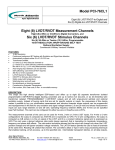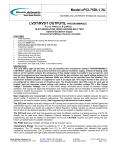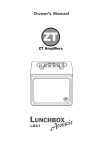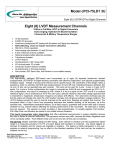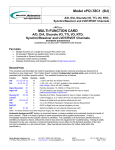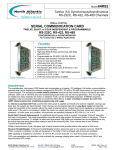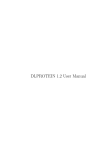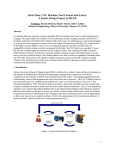Download Model PCI-76CS2 Twelve (12) S/D
Transcript
Model PCI-76CS2 Twelve (12) S/D Channels Twelve (12) S/D Single Speed or Two-Speed, Programmable Multi-Speed Ratios: 2 to 255 Continuous Self-Test; On-Board Programmable Reference Supply (Optional) FEATURES: • • • • • • • • • • • • • • • 16 bit resolution 1 arc minute accuracy Continuous background bit testing with Reference and Signal loss detection Power-On Self-Test (POST) S/D channels are self-calibrating Automatically supports either 5V or 3.3V PCI bus 47 Hz to 10 kHz Variations available Encoder (A & B) plus Index Outputs with Programmable resolution-Optional Synchro/Resolver Programmable-Optional (Measurement side S/D) Transformer isolated Accurate Digital Velocity outputs Latch feature Synthetic reference for S/D compensates for ±60° phase shift No adjustments or trimming required Part number, S/N, Date code, & Rev. in non-volatile memory DESCRIPTION: This single slot card contains separate transformer isolated Synchro/Resolver-to-Digital tracking converters, optional internal 5 VA reference, and extensive diagnostics. The measurement channels incorporate Synchro/Resolver inputs, high linearity digital velocity outputs, angle change alert and ability to field configure for either single speed or multi-speed to any ratio between 2 and 255. The S/D channels, even when large accelerations are encountered, never lose tracking, because they incorporate the unique capability to automatically shift to higher bandwidths. The shifting is smooth and continuous with no glitches. Tracking rates are only limited to bandwidth restrictions, up to 150 RPS, at 16-bit resolution. The “Latch” feature permits the user to read all channels at the same time. The use of Type II servo loop processing techniques enables tracking, at full accuracy, up to the specified tracking rate. A step input will not cause any hang-up condition. Intermediate transparent latches, assure that current valid data is always available for any channel without effecting the tracking performance of the converters. For two-speed applications, our ambiguity circuits maintain monotonic outputs by compensating for variations of the zero positions between the Coarse and Fine Synchros. However, if the maximum allowable angle difference of 90°/n is exceeded, a flag will be set that indicates to the user that the input Synchro’s are out of alignment. To simplify logistics, Part number, S/N, Date code, & Rev. are located in non-volatile memory locations. Major diagnostics are incorporated that offer substantial improvements to system reliability because user is immediately alerted to channel malfunctions. This approach also reduces bus traffic because the Status Registers do not require constant polling. Power-On, Self-Test (POST) diagnostic can immediately initiate (D3) test. See Programming Instructions for further details. Three different tests (one on-line and two off-line) can be selected: The (D2) test for measurement channels initiates automatic background bit testing. Each channel is checked every 5° to a test accuracy of 0.05°. Any failure triggers an Interrupt (if enabled) and the results are available in the S/D Test Status Registers. The testing is totally transparent to the user, requires no external programming, has no effect on the standard operation of this card and can be enabled or disabled via the bus. North Atlantic Industries, Inc. 110 Wilbur Place, Bohemia, NY 11716 631.567.1100/631.567.1823 (fax) www.naii.com / e-mail:[email protected] 6/29/2004 Cage Code:OVGU1 76_CS2_A001_Rev_1.9.docc Page 1 of 11 In addition, each S/D Signal and Reference input is continually monitored. Any failure triggers an Interrupt (if enabled) and the results are available in the S/D Signal and Reference Status Registers. The (D3) or POST test, (if enabled), is an initiated bit test that disconnects all input channels from the outside and connects them across internal test signals that generate and test 72 different angles to a test accuracy of 0.05°. External reference is not required. Any failure triggers an Interrupt (if enabled). Testing requires no external programming, and can be enabled or disabled via the bus. The (D0) test is used to check the card and the interface. All input channels are disconnected from the outside and connected across the internal test signals, thus allowing user to write any angle to the card and then read the data from the interface. External reference is not required. SPECIFICATIONS: Applies to each Measurement channel Resolution: Accuracy: 16 bit (Up to 24 bit for two-speed mode) ±1 arc minute for single speed inputs (±1 arc minute divided by gear ratio for two-speed) 18.5 RPS for 60 Hz version; 150 RPS for 360 Hz or greater versions. (Referred to the Fine input for two-speed configuration) 10 Hz for 60 Hz versions; 40 Hz for 400 Hz versions, & 100 Hz for greater than 1 kHz version. (also can be factory customized) Synchro or Resolver, (See part number) Resolver : 2-28 V L-L Autoranging, or 90 V L-L Synchro : 11.8 V L-L , or 90 V L-L Resolver and Synchro are transformer isolated Other input options available; consult factory. 26 V L-L or less: 40 kΩ min. 90 V L-L: 100 kΩ min. 2-115 Vrms, @ 5 ma max ; Transformer isolated. (See part number) 47 Hz to 10 kHz (See part number) Either 12,13,14,15, or 16-bit resolution, (field programmable) with Index marker. 12-bit resolution is equivalent to 1,024 cycles (4,096 transitions), 13-bit is 2,048 cycles (8,192 transitions) etc. After the encoder resolution has been selected, (12-16 Bits), it will not change with varying input speeds. Differential outputs are complementary TTL (use TTL+ and dc gnd for short distances or TTL(+) and (–) in the differential mode, into differential receivers for long distance to avoid ground noise ). Optional, see P/N. Equivalent to the A, B, C outputs from Hall Effect Sensors for 4, 6 or 8 pole motors The synthetic reference circuit automatically compensates for phase shifts between the transducer excitation and output up to ±60° 16 bit resolution; Linearity: 0.1% Programmable from 2 to 255. Each channel can be set to a different angle differential. When that differential is exceeded, an interrupt is generated. Default is disabled. Msb = 180°; Minimum differential is 0.05°. Max differential that can be programmed is 179.9°. Tracking Rate: Bandwidth: Input format: Input voltage: Input Impedance: Reference/Input: Frequency: Encoder outputs: Commutation outputs: Phase shift: Velocity, Digital: Two-speed ratio: Angle change alert: REFERENCE SUPPLY: Optional. (See part number). Voltage: 2.0-28Vrms programmable, resolution 0.1Vrms, or 115Vrms fixed. Accuracy ±2% 360 Hz to 10 kHz ±1% with 1 Hz resolution. 10% max. No load to full load. 5VA max. @ 40° min. inductive; 190mA RMS @ 2-26VAC, 45mA RMS @ 115VAC Note: Power is reduced linearly as the Reference Voltage. Frequency: Regulation: Output power: GENERAL SPECIFICATIONS: Signal Logic Level: Power: Temperature, operating: Temperature, storage: Size: Weight: North Atlantic Industries, Inc. 110 Wilbur Place, Bohemia, NY 11716 Automatically supports either 5V or 3.3V PCI bus. See current requirement Table 1 below. Power supplies must be able to supply the peak power without current limiting. “C” = 0°C to +70°C, “E” = -40°C to +85°C (See part number) -55° C to +105° C 3.950 (10.033) height, 12.285 (31.204) length; less front panel connector J1; dimensioned in inches (cm) Board & heat sink less modules 10 oz. Max. S/D modules @ 4 Ch ea. 2.5 oz. Max. Reference module 1.8 oz. Max. 631.567.1100/631.567.1823 (fax) www.naii.com / e-mail:[email protected] 6/29/2004 Cage Code:OVGU1 76_CS2_A001_Rev_1.9.doc Page 2 of 11 CURRENT REQUIREMENTS: ±12Vdc 15mA 15mA Board – no Modules Add per 4 Ch S/D Mod Reference Module +5Vdc 460mA 160mA 1A @ 5VA Load (3A Peak) TABLE 1 PROGRAMMING INSTRUCTIONS AND REGISTER MAP 000 004 008 00C 010 014 018 01C 020 024 028 02C 030 034 038 03C 040 044 048 04C 050 054 058 05C 060 064 068 06C 070 074 078 07C 080 084 088 08C 090 094 098 09C 0A0 0A4 0A8 S/D Ch.1 Data 1 S/D Ch.2 Data Hi S/D Ch.3 Data 1 S/D Ch.4 Data Hi S/D Ch.5 Data 1 S/D Ch.6 Data Hi S/D Ch.7 Data 1 S/D Ch.8 Data Hi S/D Ch.9 Data 1 S/D Ch.10 Data Hi S/D Ch.11 Data 1 S/D Ch.12 Data Hi Velocity, S/D Ch.1 Velocity, S/D Ch.2 Velocity, S/D Ch.3 Velocity, S/D Ch.4 Velocity, S/D Ch.5 Velocity, S/D Ch.6 Velocity, S/D Ch.7 Velocity, S/D Ch.8 Velocity, S/D Ch.9 Velocity, S/D Ch.10 Velocity, S/D Ch.11 Velocity, S/D Ch.12 Ratio S/D Ch.1/2 Ratio S/D Ch.3/4 Ratio S/D Ch.5/6 Ratio S/D Ch.7/8 Ratio S/D Ch.9/10 Ratio S/D Ch.11/12 Angle Δ Ch.1 Angle Δ Ch.2 Angle Δ Ch.3 Angle Δ Ch.4 Angle Δ Ch.5 Angle Δ Ch.6 Angle Δ Ch.7 Angle Δ Ch.8 Angle Δ Ch.9 Angle Δ Ch.10 Angle Δ Ch.11 Angle Δ Ch.12 Angle Δ initiate read read read read read read read read read read read read read read read read read read read read read read read read read/write read/write read/write read/write read/write read/write read/write read/write read/write read/write read/write read/write read/write read/write read/write read/write read/write read/write write 0AC 0B0 0B4 0B8 0BC 0C0 0C4 0C8 0CC 0D0 0D4 0D8 0DC 0E0 0E4 0E8 0EC 0F0 0F4 0F8 0FC 100 104 108 10C 110 114 118 11C 120 124 128 12C 130 134 138 13C 140 144 148 14C 150 154 Active channels, S/D Test (D2) verify, S/D Test Enable, S/D Status, Signal S/D Status, Reference S/D Status, Test S/D Latch S/D Test angle Angle Δ alert Synchro/Resolver Lock loss (A&B) resolution/poles Ch. 1 (A&B) resolution/poles Ch. 2 (A&B) resolution/poles Ch. 3 (A&B) resolution/poles Ch. 4 (A&B) resolution/poles Ch. 5 (A&B) resolution/poles Ch. 6 (A&B) resolution/poles Ch. 7 (A&B) resolution/poles Ch. 8 (A&B) resolution/poles Ch. 9 (A&B) resolution/poles Ch. 10 (A&B) resolution/poles Ch. 11 (A&B) resolution/poles Ch. 12 Velocity, S/D scale Ch.1 Velocity, S/D scale Ch.2 Velocity, S/D scale Ch.3 Velocity, S/D scale Ch.4 Velocity, S/D scale Ch.5 Velocity, S/D scale Ch.6 Velocity, S/D scale Ch.7 Velocity, S/D scale Ch.8 Velocity, S/D scale Ch.9 Velocity, S/D scale Ch.10 Velocity, S/D scale Ch.11 Velocity, S/D scale Ch.12 1 S/D Ch.2 Data Lo 1 S/D Ch.4 Data Lo 1 S/D Ch.6 Data Lo 1 S/D Ch.8 Data Lo 1 S/D Ch.10 Data Lo 1 S/D Ch.12 Data Lo Not Used Not Used TABLE 2 read/write read/write read/write read read read write read/write read read/write read read/write read/write read/write read/write read/write read/write read/write read/write read/write read/write read/write read/write read/write read/write read/write read/write read/write read/write read/write read/write read/write read/write read/write read/write read read read read read read 158 Not Used 15C Not Used 160 Not Used 164 Not Used 168 Not Used 16C Not Used 170 Not Used 174 Not Used 178 Not Used 17C Not Used 180 Not Used 184 Not Used 188 Not Used 18C Not Used 190 Not Used 194 Not Used 198 Not Used 19C Not Used 1A0 Not Used 1A4 Not Used 1A8 Not Used 1AC Not Used 1B0 Not Used 1B4 Not Used 1B8 Not Used 1BC Not Used 1C0 Not Used 1C4 Interrupt Enable 1C8 Interrupt Status 1CC Freq. (Ref. Supply) 1D0 Voltage (Ref. Supply) 1D4 Watchdog timer 1D8 Soft reset 1DC Part # 1E0 Serial # 1E4 Date code 1E8 Rev level PCB 1EC Rev. level S/D DSP Master 1F0 Rev. level S/D FPGA Master 1F4 Rev. level S/D DSP Slave 1F8 Rev. level S/D FPGA Slave 1FC Rev. level Interface FPGA 200 Board Ready read/write read read/write read/write read/write write read read read read read read read read read read Note 1 – Read channels (2,4,6,8,etc.) for combined 16-bit output. For 24 bit resolution, read Hi then Lo word. When read, Hi word latches Lo word. North Atlantic Industries, Inc. 110 Wilbur Place, Bohemia, NY 11716 631.567.1100/631.567.1823 (fax) www.naii.com / e-mail:[email protected] 6/29/2004 Cage Code:OVGU1 76_CS2_A001_Rev_1.9.doc Page 3 of 11 Register Bit Map D15 D14 D13 D12 1 180 90 45 22.5 Data (angle)° Hi 1 .00274 .00137 .00068 .00034 Data (angle)° Lo Active channels, S/D X X X X Latch outputs X X X X X Two-speed lock loss X X X Synchro/Resolver X X X X X X X X Test Enable, S/D Status, Test S/D X X X X Status, Signal S/D X X X X X X X X Status, Reference S/D X X X X Angle Δ Alert S/D Interrupt Enable/Status X X X X (A&B) resolution/poles D15 X X X ↑ "0"= Encoder "1"= Commutation Note 1 –Values are rounded off. D11 11.25 .00017 SD12 X 11/12 SD12 X SD12 SD12 SD12 SD12 X X D10 D9 D8 D7 5.625 2.813 1.406 .703 .00008.00004.00002 0 SD11 SD10 SD9 SD8 X X X X X X Ch7/8 9/10 SD11 SD10 SD9 SD8 X X X X SD11 SD10 SD9 SD8 SD11 SD10 SD9 SD8 SD11 SD10 SD9 SD8 SD11 SD10 SD9 SD8 #7 #6 #5 X X X X X D6 .352 0 SD7 X X SD7 X SD7 SD7 SD7 SD7 X X D5 D4 D3 .176 .088 .044 0 0 0 SD6 SD5 SD4 X X X Ch5/6 X Ch3/4 SD6 SD5 SD4 X X D3 SD6 SD5 SD4 SD6 SD5 SD4 SD6 SD5 SD4 SD6 SD5 SD4 X X #4 X X X 4 pole 16 bit TABLE 3 6 pole 15 bit 8 pole 14 bit 13 bit Commutation outputs ↑ 12 bit Encoder outputs D2 .022 0 SD3 X X SD3 D2 SD3 SD3 SD3 SD3 #3 D2 0 0 0 0 1 D1 .011 0 SD2 1 Ch1/2 SD2 X SD2 SD2 SD2 SD2 #2 D1 0 0 1 1 0 D0 .0055 0 SD1 X X SD1 D0 SD1 SD1 SD1 SD1 #1 D0 0 1 0 1 0 ↑ INTERRUPT ENABLE & STATUS REGISTERS #1 = S/D Signal Loss #2 = S/D Reference Loss #3 = S/D Angle Change Alert (Global – Read Angle Change Alert Register for particular channel failure) #4 = S/D Test Accuracy Error S/D FUNCTIONS S/D Active Channels: Set the bit corresponding to each channel to be monitored during BIT testing in the S/D Active Channel Register (“1”=active; “0”=not used). Omitting this step will produce errors on unused channels causing false alarms; hence unused channels will set faults, i.e. status bits, interrupts, etc. Save Setup: Writing 5555h to the Save Register will save the current setup. This location will automatically clear to 0000h when save is completed (within 5 seconds). When save is elected, all parameters are saved. However, any parameter can be changed at any time. Saving is optional. If not saved, reenter parameters at each Power-On. To restore factory shipped parameters, write AAAAh to the Save Register, followed by System Reset. Note: After a SAVE or RESTORE, poll the Save Register and do not perform any operation until word is at 0000h. Optional Synchro/Resolver Mode: Where applicable, write a “1” or “0” (Synchro = 1; Resolver = 0) to each bit, representing a channel, of Synchro/Resolver Register. S/D Ratio: Enter the desired ratio, as an integer number, in the S/D Ratio Register corresponding to the pair of channels to be used for a two-speed channel. Example: Single speed = 1; 36:1 = integer 36. Read: For single speed applications (Ratio=1), read individual channels 1,2,3,4,etc. For two-speed applications, read only channels (2,4,6,8,etc.) for the combined output of 16 bits. For resolution up to 24 bits, read Data Hi word, then Data Lo word. Data Hi word, when read, latches low word. In two-speed S/D applications, the single speed information (coarse) from the synchro should be connected to the odd channel of the pair. The N-speed information (multi-speed, fine) from the synchro should be connected to the even channel of the pair. The pairs are defined as: CH1 & 2, CH3 & 4, CH5 & 6, CH7 & 8, CH9 & 10, or CH11 & 12. Two-Speed Lock-Loss: The card monitors misalignment between Coarse and Fine angles during twospeed operation. A two-speed lock loss condition exists if the maximum allowable misalignment between the Coarse and Fine angles of 90°/ratio is exceeded. The corresponding bit for that channel pair in the Two-Speed Lock-Loss Register will be set to “0”. Latch: Writing the integer 2 to the Latch Register will cause the angle data of all channels to be latched. Reading a particular channel will disengage the latch for that channel. Writing 0 to this register will disengage latch on all channels. North Atlantic Industries, Inc. 110 Wilbur Place, Bohemia, NY 11716 631.567.1100/631.567.1823 (fax) www.naii.com / e-mail:[email protected] 6/29/2004 Cage Code:OVGU1 76_CS2_A001_Rev_1.9.doc Page 4 of 11 Velocity Output: Read Velocity Registers of each channel as a 2’s complement word, with 7FFFh being maximum CW rotation, and 8000h being maximum CCW rotation. When max. velocity is set to 152.5878 RPS, an actual speed of 10 RPS CW would be read as 0863h. When max. velocity is set to 152.5878 RPS, an actual speed of 10 RPS CCW would be read as F79Ch. When max. velocity is set to 50.8626 RPS, an actual speed of 10 RPS CW would be read as 192Ah. When max. velocity is set to 50.8626 RPS, an actual speed of 10 RPS CCW would be read as E6D5h. To convert a velocity word to RPS: Velocity in RPS = Maximum x Output / Full Scale If Velocity Output were E6D5h, and maximum velocity were 50.8626 RPS, then Velocity in RPS = 50.8626 x E6D5h / 32,768 = 50.8626 x -6,442 / 32,768 = -10 RPS Velocity Scale Factor: The velocity scale factor is used to achieve a greater resolution at lower rotational speeds (RPS). The scale factor is: 4095(152.5878RPS/max RPS), where the max RPS is selected by the user to achieve the maximum resolution for a desired RPS. Enter the scale factor as an integer to the corresponding Velocity Scale Register for that particular channel. To scale the Max Velocity word for 152.5878 RPS, set Velocity Scale Factor = 4095 (max velocity word of +32,767 (7FFFh) being 152.5878 RPS for CW rotation, and -32,768 (8000h) being 152.5878 RPS for CCW rotation). Scaling effects only the Velocity output word and not the dynamic performance. To get a maximum velocity word (32,767) @ 152.5878 RPS, Scale Factor = 4095(152.5878/152.5878) = 4095 = 0FFFh; This results in a velocity resolution of: (152.5878 RPS/32,767) x 360°/RPS = 1.676°/sec (factory default) To get a maximum velocity word (32,767) @ 50.8626 RPS, Scale Factor = 4095(152.5878/50.8626) = 12,285 = 2FFDh); This is a velocity resolution of: (50.8626 RPS/32,767) x 360°/RPS = 0.5588°/sec For 9.5367 RPS max, Scale Factor = 4095(152.5878/9.5367) = 65,520 = FFF0h; 0.10477 °/sec resolution (lowest setting) S/D Power-On Self-Test (POST): The unit will initiate the D3 Test upon power-on, if POST is enabled and saved. Enable by writing "1" to POST Register. Disable by writing "0" to POST Register and then save setup. S/D D2 Test Enable: Writing “1” to the D2 bit of the S/D Test Enable Register initiates automatic background BIT testing that checks each channel every 5° to a test accuracy of 0.05°. The result of an accuracy error is available in the S/D Test Status Register and if enabled, an interrupt will be generated (See Interrupt Register). A “0” deactivates this test. The testing is totally transparent to the user, requires no external programming, has no effect on the standard operation of this card and can be enabled or disabled. The card will write 55h to the S/D Test (D2) Verify Register, every 30 seconds, when the D2 Test is enabled. User can periodically clear the Test (D2) Verify Register by writing 00h, waiting 30 seconds, then reading the register again to verify that background BIT testing is activated. In addition, each S/D Signal and Reference input is continually monitored. Any failure triggers an Interrupt (if enabled) and the results are available in the S/D Signal and Reference Status Registers. S/D D3 Test Enable: Writing “1” to the D3 bit of the S/D Test Enable Register initiates a BIT test that disconnects all channels from the outside world and connects them across an internal stimulus that generates and tests 72 different angles to a test accuracy of 0.05°. External reference is not required. The test cycle is completed within 45 seconds and results can be read from the S/D Test Status Registers when D3 bit changes from “1” to “0” and if enabled, an interrupt will be generated if a BIT failure is detected (See Interrupt Register). The testing can be terminated at any time by writing "0" to D3 bit of the S/D Test Enable Register. Signal and Reference monitoring is disabled during D3 test. S/D D0 Test Enable: Used to check card and PC interface. Writing “1” to the D0 bit of the S/D Test Enable Register disconnects all channels from the outside world and connects them to internal test signals, enabling the user to generate any test angle by writing an integer value, to the S/D Test Angle Register. Data is then read through the interface (after writing, allow 400 ms before reading). External reference is not required. (e.g. 330° = angle/(360/216) ). Signal and Reference monitoring is disabled during D0 test. S/D Status, Test: Check the channel’s corresponding bit of the S/D Test Status Register for status of BIT testing for each active channel. A ”1” means accuracy passes; A “0” indicates a failure on an active channel. Channels that are inactive are also set to “0”. (Test cycle takes 45 seconds for accuracy error). Any S/D Test status failure, transient or intermittent will latch the S/D Test Status Register. Reading will unlatch register. S/D Status, Reference: Check the channel’s corresponding bit of the S/D Reference Status Register for status of the reference input for each active channel. A ”1” means Reference ON, a “0” means Reference Loss on active channels. Channels that are inactive are also set to “0”. (Reference loss is detected within 2 North Atlantic Industries, Inc. 110 Wilbur Place, Bohemia, NY 11716 631.567.1100/631.567.1823 (fax) www.naii.com / e-mail:[email protected] 6/29/2004 Cage Code:OVGU1 76_CS2_A001_Rev_1.9.doc Page 5 of 11 seconds). Reference monitoring is disabled during D3 or D0 Test. Any S/D Reference status failure, transient or intermittent will latch the S/D Reference Status Register. Reading will unlatch register. S/D Status, Signal: Check the corresponding bit of the S/D Signal Status Register for status of the input signals for each active channel. A "1" means Signal is valid (level must be a minimum of 2V), a “0” means Signal loss on active channels. Channels that are inactive are also set to “0”. (Signal loss is detected after 2 seconds). Signal monitoring is disabled during D3 and D0 test. Channels that are inactive are also set to “0”. Any S/D Signal status failure, transient or intermittent will latch the S/D Signal Status Register. Reading will unlatch register. Now, let us consider what happens when a status bit changes before registers are read. For example, if a reference loss was detected and latched into registers and subsequent scans find that the reference was reconnected, then this status change will be held in background until registers are read. After reading, registers will be updated with the background data within 250ms. Allow 250 ms to scan all channels. Angle Change Alert: Write a 16-bit word to the appropriate Angle Change Register for a given channel, to represent the minimum differential change required. MSB=180°; Minimum differential is 0.05°, setting to zero disables the Angle Change Alert for a given channel. Initiate monitoring by writing “1” to Angle Change Initiate Register. When that differential is exceeded, on any monitored channel, the bit corresponding to that channel is set in Angle Change Alert Register ("0" = no change, "1" = change). Optional (A&B) Encoder Resolution: To set Encoder Mode, write a “0” to the D15 bit and the appropriate code for the desired resolution to the D2, D1 & D0 bits of the corresponding channel (A&B) Resolution/Poles Register. Changing the resolution for any channel can be done on the fly. The default is a 12bit resolution encoder output. See Table 3. Note: Encoder/Commutation outputs are optional; see part ordering information. Optional Commutation Outputs (A,B,C): To set Commutation Mode, write a “1” to the D15 bit and the appropriate code for the required motor poles to the D2, D1 & D0 bits of the corresponding channel (A&B) Resolution/Poles Register. See Register Bit map table. Note: Encoder/Commutation outputs are optional; see part ordering information. Power On Reset or System Reset: All parameters are restored to last saved setup and, if POST was previously enabled in last setup, a D3 Test will be initiated. A power on automatic calibration test is run and completes in approximately 30 seconds. Interrupt Registers: Interrupts can be enabled to relay specific problems/failures detected by the card. The problem/failures that generate these interrupts are: S/D Signal Loss, S/D Reference Loss, S/D Angle Change Alert, S/D Test Accuracy Error, Each external interrupt can be enabled individually. This is accomplished by writing a “1” to the bit corresponding to desired interrupts to the Interrupt Enable Register and a “0” to disable those interrupts not used. Refer to Table 3. Interrupt Status Registers: When an interrupt is initiated via a problem/failure, the Interrupt Status Register can be interrogated by a read to identify, which interrupt occurred. Refer to Table 3. Register is latched when interrupt is generated and unlatched when read. Note: This register is typically read and cleared by the device driver. Subsequent readings of this register will give clear status. Optional Reference Supply: For frequency, write a 16-bit integer to the Frequency Ref Supply Register. (Ex: 400 Hz = 0190h) with LSB= 1Hz. For voltage, write a 16-bit integer to the Voltage Ref Supply Register. (Ex: 26Vrms =0104h) with LSB=0.1Vrms. It is recommended that the user program the required frequency before setting the output voltage. Soft Reset: Write an integer “1” to Soft Reset Register, then clear to 0 before 50ms elapses. CAUTION: Register is level sensitive and for proper card operation, the logic level “1”, or pulsewidth, must be <= 50ms. Considering minimum and maximum, 1 μs < pulsewidth <= 50ms. Processor reboots in about 400 ms, after which calibration procedures begin. This function is equivalent to a power-on reset. Watchdog Timer: This feature monitors the Watchdog Timer Register. When it detects that a code has been received, that code will be inverted within 100 µsec. The inverted code stays in the register until replaced by a new code. The user should look for the inverted code, after 100 µsec, to confirm that the processor is operating. North Atlantic Industries, Inc. 110 Wilbur Place, Bohemia, NY 11716 631.567.1100/631.567.1823 (fax) www.naii.com / e-mail:[email protected] 6/29/2004 Cage Code:OVGU1 76_CS2_A001_Rev_1.9.doc Page 6 of 11 Part Number: Read as a 16-bit binary word from the Part Number Register. A unique 16 bit code is assigned to each model number. Serial Number: Read as a 16-bit binary word from the Serial Number Register. This is the serial number of that particular board. Date Code: Read as decimal number from the Date Code Register. Four digits represent YYWW (Year, Year, Week, Week) Rev Levels: There are a total of 6 Revision Level Registers, which are listed below. Each register is defined as 16 bits. The integer value of that particular register corresponds to the actual revision. Rev level PCB Rev level S/D DSP Master Rev level S/D FPGA Master Rev level S/D DSP Slave Rev level S/D FPGA Slave Rev level Interface FPGA Board Ready: When board initialization is completed (& auto-cal for A/D modules), after as much as 10 seconds, the board is ready for access and the Board Ready register is set High. Software - PCI Programming This section provides programmers the information needed for developing drivers other than those supplied. The following information resides in the PCI configuration registers: Device ID Vendor ID Rev Subsystem ID = 7622 = 15AC = 01 = 000115AC (hex) (hex) (hex) (hex) Base Address = Assigned by the PCI BIOS. Interrogate the PCI BIOS for this information. Required Address space = 1K for each card. EXTERNAL +/- 12VDC: (JP6 & JP7) The card is shipped and configured for operation with +/- 12 VDC power, being supplied from edge connector. To operate from External +/- 12VDC supplies: On jumper block JP7, remove jumpers 1-2, and 5-6, then reconnect jumpers 3-4 and 7-8. Leave jumper 9 – 10 connected. Connect external +12 VDC to JP6-4, connect external –12 VDC to JP6-2 and external ground to JP6-1. Pin JP6-3 has been removed for keying. We recommend customer plug receptacle pin 3 to insure proper connection and avoid damage. North Atlantic Industries, Inc. 110 Wilbur Place, Bohemia, NY 11716 631.567.1100/631.567.1823 (fax) www.naii.com / e-mail:[email protected] 6/29/2004 Cage Code:OVGU1 76_CS2_A001_Rev_1.9.doc Page 7 of 11 4 3 2 1 JP6 1 2 4 1 3 JP4 26 25 2 4 1 3 JP5 48 50 47 49 2 JP7 9 10 78 59 39 20 COMPONENT SIDE OF BOARD J1 60 40 21 1 Figure 1 Connector: JP6 Samtec TSW 104-14-L-S Mate: Amp 87499-4, Keying Plug 86286-1 Pin 1 2 3 4 Function External Ground External (-12VDC) Removed for Keying External(+12VDC) TABLE 4 North Atlantic Industries, Inc. 110 Wilbur Place, Bohemia, NY 11716 631.567.1100/631.567.1823 (fax) www.naii.com / e-mail:[email protected] 6/29/2004 Cage Code:OVGU1 76_CS2_A001_Rev_1.9.doc Page 8 of 11 12 S/D Channels Connector: J1 –12 S/D AMP 748483-5 Mate: AMP 748368-1 Pin Ch.1 S/D 39 S1 58 S2 78 S3 19 S4 38 Rhi 77 RLo Pin Ch.2 S/D 18 S1 76 S2 S3 57 S4 37 17 Rhi 56 RLo Pin Ch.3 S/D Pin 36 S1 15 55 S2 73 75 S3 54 16 S4 34 35 Rhi 14 74 RLo 53 Ch.4 S/D S1 S2 S3 S4 Rhi RLo Pin Ch.5 S/D Pin Ch.6 S/D 33 S1 12 S1 52 S2 70 S2 72 S3 51 S3 13 S4 31 S4 32 Rhi 11 Rhi 71 RLo 50 RLo Pin Ch.7 S/D 30 S1 49 S2 69 S3 10 S4 29 Rhi 68 RLo Pin Ch.8 S/D 9 S1 67 S2 48 S3 28 S4 8 Rhi 47 RLo Pin Ch.9 S/D Pin Ch.10 S/D Pin Ch.11 S/D 27 S1 6 S1 24 S1 46 S2 64 S2 43 S2 66 S3 45 S3 63 S3 7 S4 25 S4 4 S4 26 Rhi 5 Rhi 23 Rhi 65 RLo 44 RLo 62 RLo Pin Ch.12 S/D Pin 3 S1 61 S2 42 S3 1 & 40 CHASSIS 22 S4 21 Int. Exc. Out Hi 2 Rhi 60 Int. Exc. Out Lo 41 RLo TABLE 5 Encoder/Commutation Outputs Connector : JP5 Samtec TSW-125-25-T-D-RA Pin 1 2 3 4 5 6 7 8 9 10 11 12 13 14 Function A Hi Ch1 A Lo Ch1 B Hi Ch1 B Lo Ch1 IDX Hi Ch1 IDX Lo Ch1 A Hi Ch2 A Lo Ch2 B Hi Ch2 B Lo Ch2 IDX Hi Ch2 IDX Lo Ch2 A Hi Ch3 A Lo Ch3 Pin 15 16 17 18 19 20 21 22 23 24 27 28 29 30 Function B Hi Ch3 B Lo Ch3 IDX Hi Ch3 IDX Lo Ch3 A Hi Ch4 A Lo Ch4 B Hi Ch4 B Lo Ch4 IDX Hi Ch4 IDX Lo Ch4 A Hi Ch5 A Lo Ch5 B Hi Ch5 B Lo Ch5 Pin 31 32 33 34 35 36 37 38 39 40 41 42 43 44 Function Pin IDX Hi Ch5 45 IDX Lo Ch5 46 A Hi Ch6 47 A Lo Ch6 48 B Hi Ch6 49 B Lo Ch6 50 IDX Hi Ch6 IDX Lo Ch6 25 A Hi Ch7 26 A Lo Ch7 B Hi Ch7 B Lo Ch7 IDX Hi Ch7 IDX Lo Ch7 Function A Hi Ch8 A Lo Ch8 B Hi Ch8 B Lo Ch8 IDX Hi Ch8 IDX Lo Ch8 GROUND GROUND TABLE 9 ENCODER OUTPUTS ARE ONLY AVAILABLE FOR CHANNELS 1 THROUGH 8 Note: Commutation outputs are differential outputs and are translated as follows: A = Ch1 A HI & LO; B = Ch1 B HI & LO; C = Ch1 IDX HI & LO North Atlantic Industries, Inc. 110 Wilbur Place, Bohemia, NY 11716 631.567.1100/631.567.1823 (fax) www.naii.com / e-mail:[email protected] 6/29/2004 Cage Code:OVGU1 76_CS2_A001_Rev_1.9.doc Page 9 of 11 CODE TABLE 01 Input Format Synchro 02 Synchro 03 Synchro 08 Resolver Code Input Ref (VL-L) Vrms 26 11.8 115 90 90 2-28 Freq. Tracking rate (Hz) (rps) at 16 bit 400 150 400 150 115 50/400 18.5 2-28 400 150 TABLE 10 See code list addendum for descriptions of code 09 and above. PART NUMBER DESIGNATION 76CS2 – 120 X X X - XX TOTAL NUMBER OF S/D CHANNELS 12 = 12 S/D Channels CODE (See Code Table) For any other number of channels, or S/D & D/S combination, see Model 76CS1 ENVIRONMENTAL C = 0°C to +70°C E = -40°C to +85°C H = E With Removable Conformal Coating K = C With Removable Conformal Coating ENCODER/COMMUTATION (2) - = Without Encoder/Commutation option E = With Encoder/Commutation option FORMAT S = Synchro R = Resolver M = Mixed (See Code Table) P = Programmable Synchro/Resolver (1) OPTIONAL REFERENCE SELECTION 0 = No “On Board Reference” A = 2-28 VRMS output C = 115 VRMS fixed output (1) Programmable Synchro/Resolver and Encoder/Commutation Options are for Measurement Channels only. (2) ENCODER OUTPUT ARE ONLY AVAILABLE FOR CHANNELS 1 – 8. FOR OTHER VARIATIONS ON TOTAL CHANNEL COUNTS (S/D AND D/S CONFIGURATIONS), PLEASE CONTACT FACTORY North Atlantic Industries, Inc. 110 Wilbur Place, Bohemia, NY 11716 631.567.1100/631.567.1823 (fax) www.naii.com / e-mail:[email protected] 6/29/2004 Cage Code:OVGU1 76_CS2_A001_Rev_1.9.doc Page 10 of 11 Revision Page Revision Description of Change Rev 1.0 Initial Release Rev 1.1 Engineer Date GS 04/04/02 Encoder output only available for channels 1 – 8. GS 04/18/02 1.2 Replaced 150 with 152.5878 rps. Affects Velocity Scale Factor and Vel Output Descriptions GS 6/27/02 1.3 For proper Soft Reset operation, 1μ < pulsewidth <=50ms. GS 6/27/02 1.4 Removed 2-13.5 volt reference option (from spec, and PN) GS 6/28/02 1.5 Removed JP6-3 for Keying GS 8/13/02 1.6 Added Encoder Output & Commutation to SPECIFICATIONS GS 8/28/02 1.7 EXTERNAL +/- 12VDC: (JP6 & JP7) GS 10/10/2 1.8 Removed feature relevant to stimulus. GS 6/29/4 1.9 Corrected device ID pg 7. FR 12/7/06 North Atlantic Industries, Inc. 110 Wilbur Place, Bohemia, NY 11716 631.567.1100/631.567.1823 (fax) www.naii.com / e-mail:[email protected] 6/29/2004 Cage Code:OVGU1 76_CS2_A001_Rev_1.9.doc Page 11 of 11











